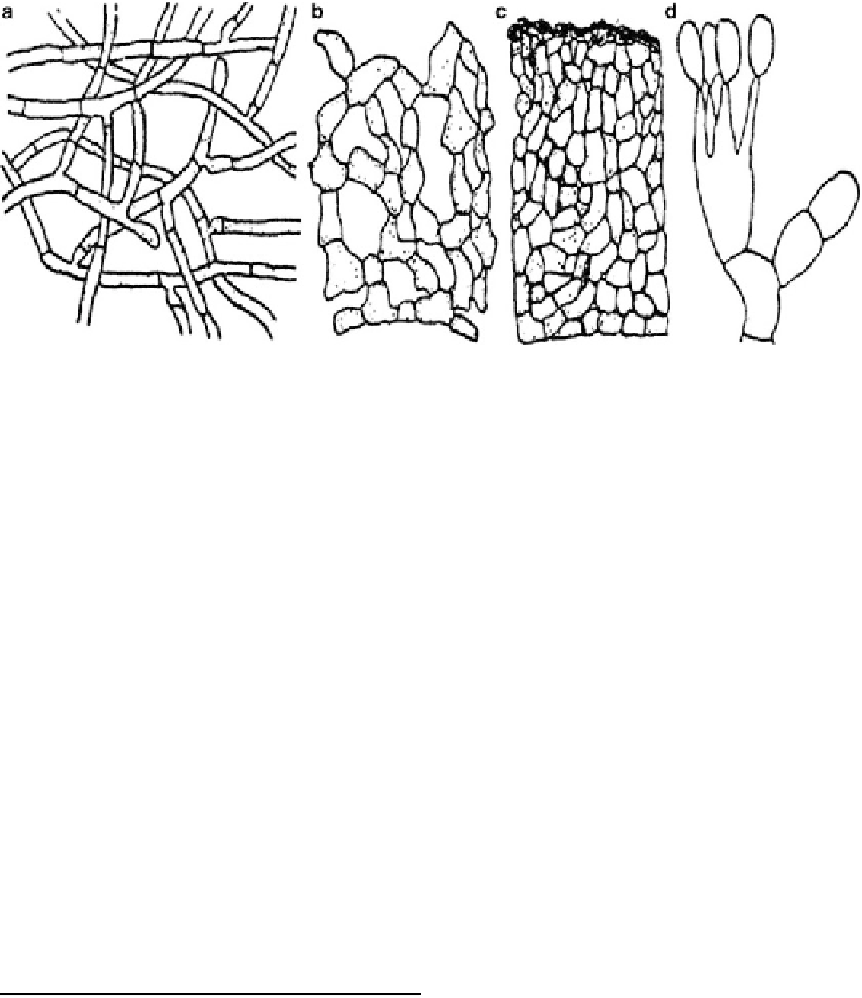Biology Reference
In-Depth Information
Fig. 8
Forms of
Rhizoctonia solani
.(a) young myce-
lium, constricted at branches; (b) loosely formed angular
to barrel-shaped colored cells;
sclerotium formed from aggregation of cells in b;
(d) basidium and spores of
Pellicularia
, teleomorph state
of
R. solani
(c)
section through
spring where tulip shoots should be showing.
Occasionally an infected bulb will produce
some above-ground growth, but the plants are
slow and often wither and die before flowering.
Bulbs rot from the top down; mycelium forms
felty masses between scales; on bulbs and in
surrounding soil are masses of brown to black,
flattened sclerotia, composed of the yellow-
brown, thin-walled irregular cells typical of
Rhi-
zoctonia
. These can survive in soil for years,
germinating to infect bulbs after planting or in
very early spring. Occasionally sclerotia are
transported on bulbs, but the bulbs are usually
so noticeably diseased that they are not sold.
Control
Remove soil and plants from affected
area and for at least 6 inches beyond. Destroy
all infected bulbs at harvest. Use a 4-to 5-year
rotation.
Rhizopus arrhizus
Soft Rot
on gladiolus corms,
light brown and on beet.
Rhizopus arrhizus (formerly
Rhizopus oryzae
).
Head Rot
on sunflower.
Rhizopus nigricans (Syn.
R. stolonifer
), the
common black bread mold.
Soft Rot
of sweet
potato and other vegetables;
Rhizopus Rot
,
“
Whiskers
,”
Leak
of peach, strawberry, and
other fruits. This is one of the more serious stor-
age rots of sweet potato, soft, watery, progressing
rapidly, with rotting complete inside 5 days after
visible infection. The tuber is brownish within,
covered with a coarse whiskery mycelial growth;
there is a mild odor. Cucurbits, crucifers, carrots,
beans, lima beans, onions, peanuts, potatoes,
Jerusalem artichoke, and guava are susceptible
to this black mold. Nancy Hall and Southern
Queen are among the more resistant varieties
of sweet potato. To prevent rot, cure at 80
to 85
F for 10 to 14 days, at high humidity, to
permit rapid corking over of wounds; then store
at 55
F.
The fungus is a weak parasite on ripe
fruit -peach, fig, strawberry, citrus, persimmon,
pear, avocado and melons. A coarse cottony mold
appearing in wounds and over the surface is cov-
ered with sporangia, white when young, black at
maturity. A watery fluid with an offensive odor
leaks from the soft fruit. Avoid wounding in
harvesting; do not pack overripe fruit; keep at
Rhizopus
Zygomyetes, Mucorales
Sporangium large, globose, multispored, with
a columella and a thin wall; sporangiola and
conidia lacking. Sporangiophores arise in fasci-
cles from aerial arching stolons, which develop
rhizoids at point of contact with substratum
(Fig. 2, chapter
Fungi
).
▶


